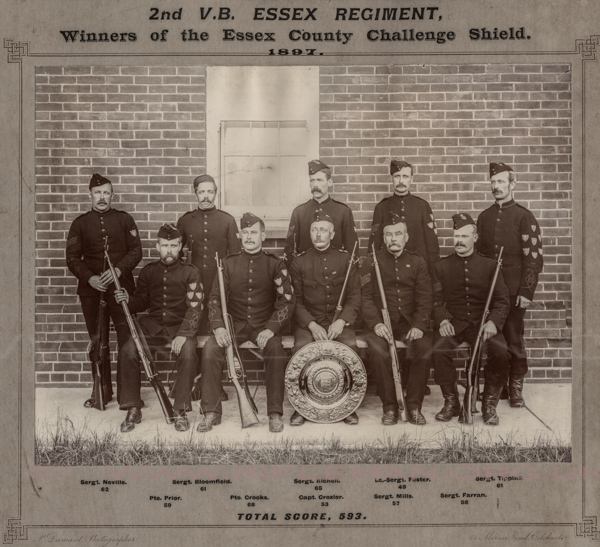
Please be aware that some specialist imagery may take time to load.
This site is designed for dedicated researchers on desktop or tablet, not ideal for mobile browsing.
Luke Ricketts Tippins was Herefordshire born, in the town of Kimbolton, ca. 1859. He started his working life in 1871 at the stables of Robert Mongo, J.P., but another ten years saw him qualified as a teacher.
He became a schoolmaster at the Boys' National School in Westerham, Kent., but his time there led to a dramatic incident that probably had a major effect on how his life was to further develop. Another teacher at the school was one Rose Ellingham who, having been engaged to a local stationmaster, Albert Saunders, broke off the engagement and took up with Luke Tippins, whom she married in 1882.
Saunders bore a serious grudge and, one night in Westerham town, approached Luke and Rose in the street carrying a pistol. In the ensuing fracas, several shots were fired, as Luke carried a twin barrelled pistol of his own for self-protection - robbery being a not uncommon occurence at the time. There were at least two misses by Saunders, and another being Luke's first reply. Saunder's next shot hit Luke in line with his heart, but was most fortunately deflected by his pocket-watch's Albert chain and fob into a pocket. (A coincidence there indeed). Luke's second shot hit Saunders in the shoulder, and he made off into the night. *
Later brought to court, Saunders was sentence to ten years imprisonment, but it was soon after that Luke and Rose moved to Mistley, next to Manningtree on the river Stour in Essex.
Luke Tippins is shown top right in the photograph below,
of the winners of the Essex County Challenge Shield in 1897.
The shooting team of the 2nd. Volunteer Batallion of the Essex Regiment,

Luke Tippins and his son John were both members of Colchester
Rifle Club, indeed Luke being a founder member. They lived at Mistley
on the River Stour. Luke was the local schoolmaster, but his interest in
rifles and ballistics led him to leave his profession and become a full
time gunsmith. Many of his rifles and shotguns are still to be found in
this country and others have been found as far away as Australia.
Luke was a man who did not mince his words, as anyone who has read his book
"Modern Rifle Shooting" will know. He was a member of all the
C.R.C. teams which challenged the Royal Warwickshire Regiment, then based
in Colchester Garrison, to a rifle match in 1900 after the club's inauguration.

Luke designed a renowned folding rear-sight bracket for the Lee-Enfield rifle,
often fitted to his custom built and sought-after "Tippins Long Lee" rifles.
Below, the 1908 patent.

The above patent had been preceded in November by one detailing the spring-loaded locking pivot
that permitted the hinging of the rear-sight. This was patent No. 24.953.
Earlier in the same year Tippins had also designed and patented a mounting arrangement to permit
adjustment of the position of the Lee-Enfield tangent rear-sight on the barrel.

The rifle below is one of Luke Tippins' specially regulated and finely finished examples of
a commercial Birmingham Small Arms Co., (B.S.A.) Charger Loading Magazine "Long" Lee-Enfield. (C.L.L.E.),
the configuration of which both then and now met/meets the N.R.A. rules for Service Rifle
competitions SR(a) and SR(b) dependent on which rear-sight was/is used.
The barrel bears the "LRT" combined letters motif on the reinforce,
and the beautifully hand-engraved name and address on the left side of the action body receiver wall.
The rifle is also fitted with the aperture rear sight as described in the previous documentation.
The tangent leaf barrel rear sight is a specially made model with fine windage adjustment.
This appears to be neither a Parker or BSA sight design,
each models of which either have single or offset double adjustment screws.
Strangely, the nearest slide design to this is perhaps to be found on the War Office 1906 Pattern Miniature Rifle
See also: "A CENTURY OF SIGHTS AND SIGHTING AIDS" by Edna Parker.
THUMBNAIL IMAGES
Image 1.
The proof marks and engraving "L.R. TIPPINS MISTLEY MANNINGTREE".
Image 2.
The Tippins BSA hinging aperture rear-sight from above -folded down.
Image 3.
Close-up of Tippins engraving.
Image 4.
Tippins "LRT" motif on the barrel reinforce, and serial number on action ring.
Image 5.
The BSA-Tippins patent aperture rear-sight from the RHS - ladder up and hinged up, showing Ross-style elevation screw.
Image 6.
The aperture rear-sight locked down, form the LHS with the locking lever in its vertical position.
Image 7.
The aperture rear-sight hinged up, from the LHS, with the locking lever in its horizontal position.
Image 8.
The barrel's B.S.A. windage adjustable
tangent rear-sight.
See the advertisements for the BSA Territorial volunteer Long Lee - and others - in the
1909 and 1912 BSA Catalogues (page 14 of the facsimile's search facility)
Around 1910-11, Tippins issued a pamphlet about his rear aperture sight.
This can be viewed as a text-searchable flip-page document
or with vertical scrolling by clicking the portrait icon.
Depending upon the number of pages it may take a few moments to load.
Double tap tablet or click ![]() for full page display.
for full page display.
An indication of the esteem in which Luke Tippins was held, in the world of target shooting,
is to be found in a contemporary review of a new book authored by Luke Tippins, in 1910, which stated
"The Rifleman's Companion"
By L. R. TIPPINS. With 6 Illustrations. Crown 8vo.
2s. 6d. net.
The author is well known as a skilled " Inter-
national " shot, who has very exceptional facilities for
experimental work. His knowledge of applied science,
joined to long experience of rifle-making, has placed
him in the front rank of rifle experts.
The new book is practical, while not neglecting
such knowledge of theory as is essential for useful
practice, and shows the rifleman how to get the
best work out of his weapon.
Tippins five published books in chronological order from left to right.
1895; 1901; 1902; 1903 and 1910
Modern Rifle Shooting for Peace, War and Sport was printed in at least three editions up to 1906.
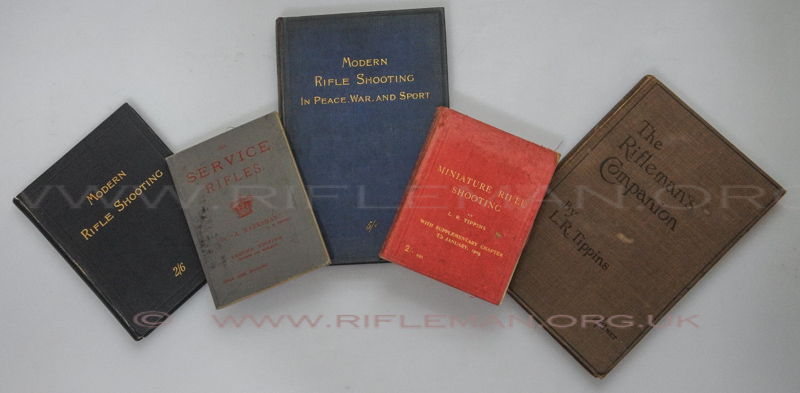
Below: the title pages in the same order.
Note that Tippins published the first two books under the assumed name "A Marksman",
rather than in his own name as was subsequently the case.
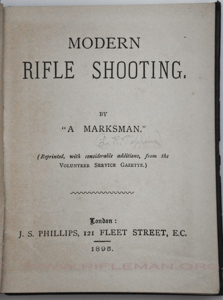


The latter two copies being signed by the author,
the Miniature Rifle Shooting edition of 1903 not being signed until 1906.




Luke represented England in the International Match of the 1908 Olympic games.
He is here right front on the ground, in illustrious company including Colonel Fremantle,
author of the famous tome "The Book of the Rifle" (1901),
and alongside H. Ommundsen, co-author with E.H. Robinson of the other significant
and highly collectible reference volume "Rifles and Ammunition".
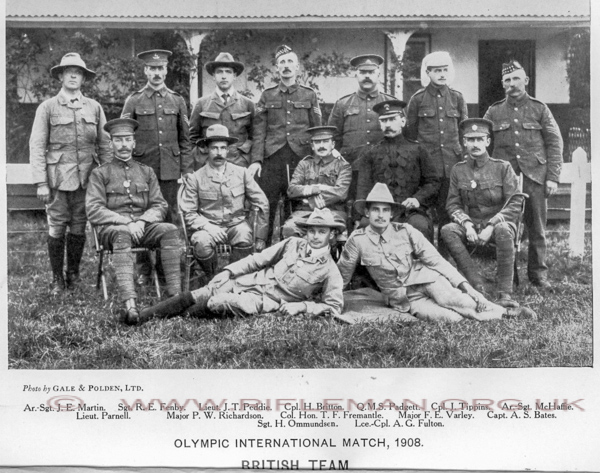
From The Guardian – 24th. October 1911
In the autumn of 1910, L.R. Tippins hauled a Maxim machine gun to the tidal mud of the river Stour in Suffolk and fired two bursts of about 30 bullets straight up into the air.
With stopwatch in hand, he timed the bullets as they fell to Earth, recording flight times of about 55 seconds.
The conclusion from the experiments was that the bullets reached 2,750 metres (9,000ft), taking 19 seconds to rise and almost twice as long – 36 seconds – to fall.
Recalling the experiment, Tippins said: "We had no head cover, but trusted to the wind to carry them away far enough to miss us."
Members of the Tippins family - ?
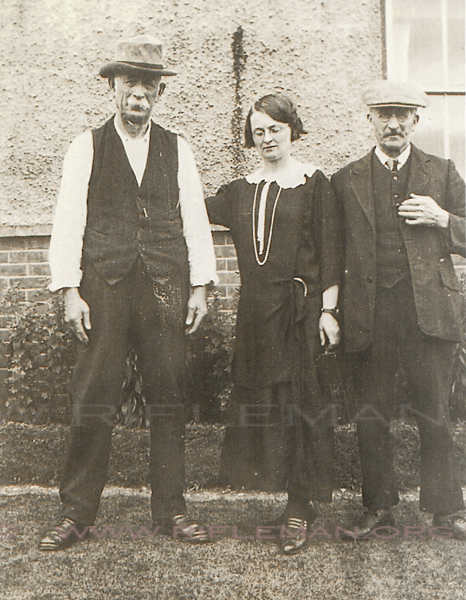
Luke Tippins, as previously mentioned, was a much respected schoolmaster in Mistley, Essex.
The young men of the area were, as was the case nationwide after the Boer War, encouraged to take up rifle shooting.
Here they are photographed with their miniature .............? rifles,
as members of the St. Michael's Rifle Club of Manningtree,
the town to which the then village of Mistley lay adjacent.

Luke Tippins set up his own full-bore rifle range by the River Stour at Brantham, directly opposite Manningtree.
The early Twentieth Century Ordnance Survey map showed the range,
the points for which lay under the railway embankment (at the centre of the map below).
The targets were set up on the edge of the saltings, with the range running East-South-East.
The line of the range pointed almost directly towards Mistley, on the other side of the river East of Manningtree.
The low tide mudflats were effectively the safety area.

The position of the range is better indicated on the satellite image below.
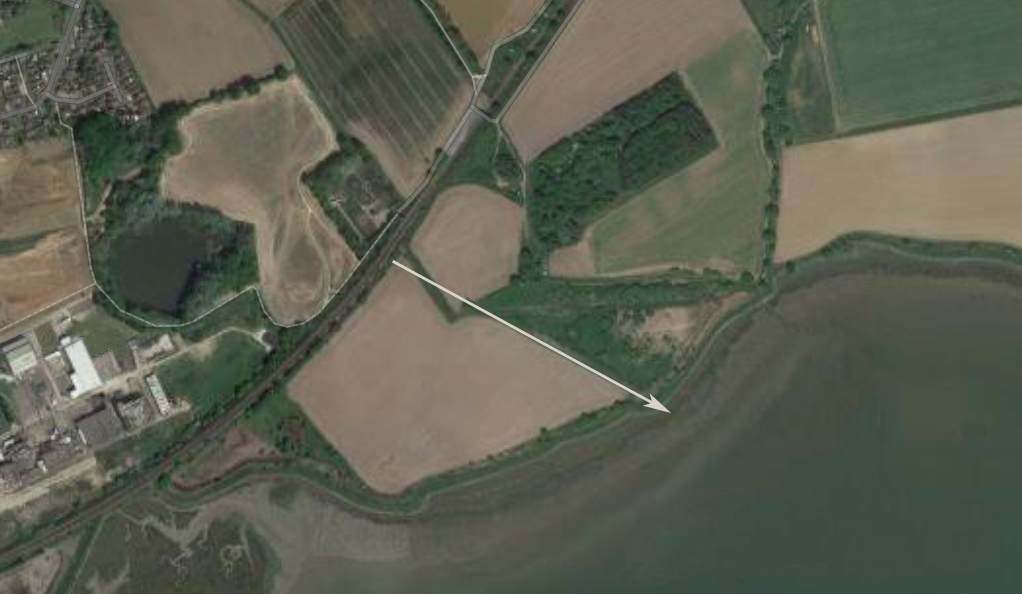
This is the view across the mudflats of Sea Field Bay from the target position near the saltings' edge.

If Luke Tippins required a greater range distance than his Brantham 600 yards for testing his rifles and ammunition, he had an agreement with the explosives manufacturer near Horsey Island, in the Walton backwaters, to use their 1,500 yard range that also ran out over mud and saltings from Bramble Island to Hamble Creek. The site was that of the Great Oakley Powder Works, and the manufactory remains extant to this day under new modern management.
The powder works are to be seen, on the 1911-13 Ordnance Survey map below, left of top centre above the points near the corner of the road that passes the buildings to the south-east, and at the start of the red arrow. The targets are presumed to have been accessed via the reverse "L' shaped high ground on the mudflats. Landing points are evident that would have served for the boat necessary for either the crossing of the creek, or transit to the low water mark in Hamford Water via Oakley Creek.
The three small arrow-heads are at approximately 500, 1,000 and 1,500 yards.
Click the image to zoom and scroll
Luke supplied .303-inch center-fire ammunition for his rifles
to shooters under his own name and with the trade name of "Rifle Club".

Being in the same region as the manufacturing company,
the Mk.VI cartridge headstamps are unsurprisingly marked "KN", presumably for Kynoch.
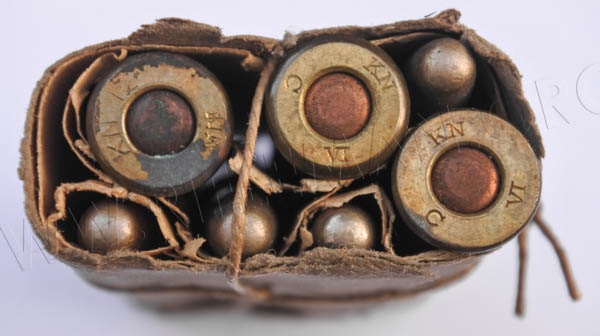

Luke Tippins authored a number of well respected books on rifles and shooting, the most notable of which was "MODERN RIFLE SHOOTING", published in several editions between 1900 and 1908. This, and his very small edition of "THE SERVICE RIFLE", related to full-bore shooting, but he also authored, in 1905, a small book called "MINIATURE RIFLE SHOOTING". As this relates perfectly to this site's remit, we have produced a flip-page document of the entire book, which carries a small number of contemporary advertisements for rifles and accessories of the time. Included amongst these are a few for some of Tippins own products, and books.
The book itself is historically important, and affords a remarkable insight into early Twentieth Century small-bore shooting, rifles and equipment.
We are extremely fortunate that the copy we hold in our archive was signed by the author in 1906.
The book is in the form of a text-searchable flip-page document that may take a few moments to load.
Double tap tablet or click ロ for full page display.
Luke Tippins is here in his workshop, known locally as "Tippins Shed".
Left to right: an unidentified 'assistant. in the flat cap. This gentleman appears far right in the rear rank of the St. Michael's R.C.
photograph, and is possibly also a local teacher. Young John Tippins stands between the assistant and John's father,
who is holding a Mauser actioned rifle over the bench.
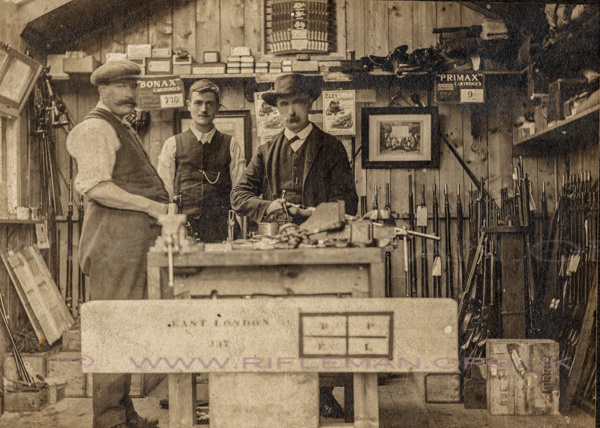
Tippins' shed still stood in the yard of the firm of Rose Ltd. (local builders) in Mistley until the Millenium.
The old workshop had remained a builder's store for more than a hundred years.
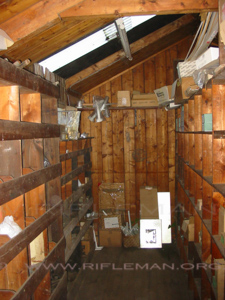 ...
...
Below: the shed, about two years before development of the yard caused its demise.
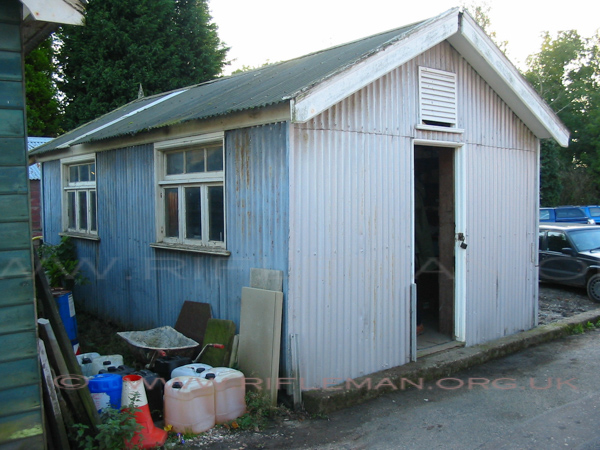
Luke Tippins passed away in 1940, having been still living at his home "The Haven" in Mistley. He had led an extraordinarily busy and varied life through dramatic times. His lifetime interest in rifles and shooting was hardly surprising, having been brought up through the Boer Wars, borne the troubles of the Great War and the loss of a son, then carrying on with both his teaching profession whilst running a business that had come out of a hobby and sporting interest. His health when in his eightieth year is not recorded, but he may still have been able to shoot, as do many at that age, but to find oneself having to spend your final years under the panoply of a second major World conflict must have been a further trial. His wife Rose had predeceased him on 2nd. April 1925.
1903 advertisements for Tippins products, including
Morris Tubes,............. Winchester rifles,............ Stevens rifles, ............. and Kynoch & Eley adaptors.
 ...........................
...........................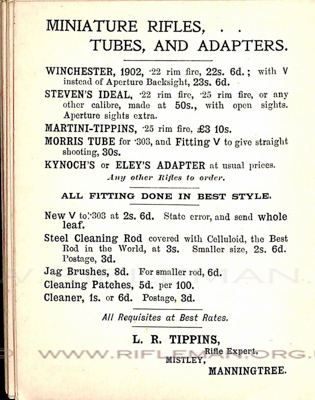
Many of these items and subjects are both discussed and illustrated
in the flip page facsimile of Tippins' book "Miniature Rifle Shooting" on this page.
Below:
a particularly rare "back-position" rifle for supine shooting.
The rifle is held in the NRA Museum at Bisley, but the rear ladder sight has been removed.
The fore-end wood has been shortened, as a shooter would rest the barrel between the feet.

The Nocksform carries Luke's "LRT" motif.

Between 1910 and 1911 Tippins issued a catalogue of his rifles and accessories.
This was a comprehensive document, also listing many of the services he offered,
A facsimile is shown below in the form of a searchable flip-page booklet.
It may take a few moments to load.
Double tap tablet or click ロ for full page display.
In 1909, A.G. Parker produced a Rifle Shooter's Score Register, which Alfred had written himself.
Fifteen years later the company issued another register that had then been authored by Luke Tippins in conjunction with A.T.C. Hale, who worked with Alf Parker prior to the setting up of their joint enterprise Parker-Hale.
The score book carries much useful information on the shooting of the Long and Short Lee-Enfield rifles, much of which applies to this day for those shooting these classic rifles.
We here copy sections of the register, including the 1925 score sheets of a contemporary shot. What is particularly interesting is that the practice and competition shoots recorded are by an Australian shooter; the ranges on which the shoots took place may be familiar to Antipodeans,and the competitions, such as "The Sofala", "The Wallerawang" and the "Blight Trophy" may well still exist. For anyone unfamiliar with the way rifle shooting scores are recorded, this may be of interest. It is also worthy of mention that little has changed in this respect over the last hundred years. The rifles, ammunition and targets are obviously different, but the methods are similar, as particularly is the wind, and many ranges remain much as they ever were.
JOHN TIPPINS
Luke's son John was born on the 10th. March 1887,
ten years before the first photograph of his father shown at the beginning of this article.
The family then lived at Winsford in Somerset, but later moved to Mistley.
John and his sister Rose (Jnr.), ca. 1908.

Below: John Tippins shooting on the Colchester range at Middlewick.
Essex County Telegraph 9th. April 1910
He is the nearest shooter in the foreground. The rifles are mostly charger-loading 'Long' Lee-Enfields, (C.L.L.E.)

Queen Victoria's state funeral was held on the 2nd. February 1901

Luke's son John was a member of the "Territorials", and is seen here in 1907, front and centre,
with the Essex based Manningtree Maxim Gun Team.
He is wearing his tunic already bearing many of his badges of competition success.

John Tippins won the National Service Rifle Championship in 1911. He was a contemporary both of L.Cpl. H. Ommundsen (later Captain) and of Arthur Fulton of Fulton's gunsmiths of Bisley Camp. Ommundsen won the King's Prize in 1901 and was five times winner of the Service Rifle Championship between 1905 and 1913. He also won the Bisley Grand Aggregate three times and was runner up twice between 1900 and 1912. Until four years ago, Arthur Fulton was the only man to win the King's / Queen's prize three times, a feat now shared by Alain Marion. In a poll taken around 1912, John Tippins was voted by his peers to be among the 10 best marksmen in the world. Sadly both John and L.Cpl Ommundsen were to be killed in the first year of the Great War. John, aged 27, shot through the heart while fetching water for a machine gun.
The rotating and zoomable image below is of the cup presented in 1906
to the Essex Rifle Team of the Volunteer Battalion, the Essex Regiment.
The score of each team member is engraved on the trophy,
and that of John Tippins, as a Private,
is at the very bottom, while his Sergeant father Luke's is fourth from the top.
The awards for the National County Championships of 1906 were presented
at a dinner held at the Holborn Restaurant in London on 1st. December that year.
The menu card for the evening is replicated in the flip-page facsimile below.
Double tap tablet or click ロ for full page display.
An article from THE RIFLEMAN February 26, 1910.
The journal of the Society of Miniature Rifle Clubs
latterly the National Small-bore Rifle Association
MEN IN MINIATURE.
No. 5.-Mr. JOHN TIPPINS.
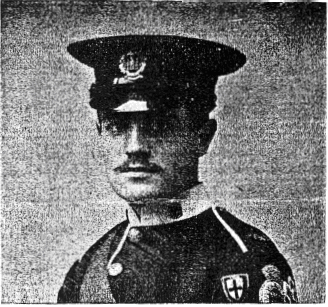
The subject of my memoir this week is not well known to
miniature shots as he has only attended about six open meetings, but as,
"A chip off the old block" the son of L. R. Tippins, one of the
greatest living authorities on the Service rifle, and a very fine shot himself
with the Lee-Enfield, without him "Men in Miniature" would be
incomplete. He started shooting at the age of sixteen with the Morris Tube
in a Martini-Henry rifle at about twelve yards range. Going straight from
this to the service weapon with full charge his first shoot at 200 yards
was a best 34 out of 35 on the then seven-inch Bisley bull. His first shoot
through the ranges was 89 and won him a Skilled Shot's Certificate.
His first shoot at Bisley the same year was in the "Ince", when
he made 68 on his first ticket at each range (unlimited entries). In his
first squadded shoot the same meeting he was second in "Halls Wine"
with 32 and 34.
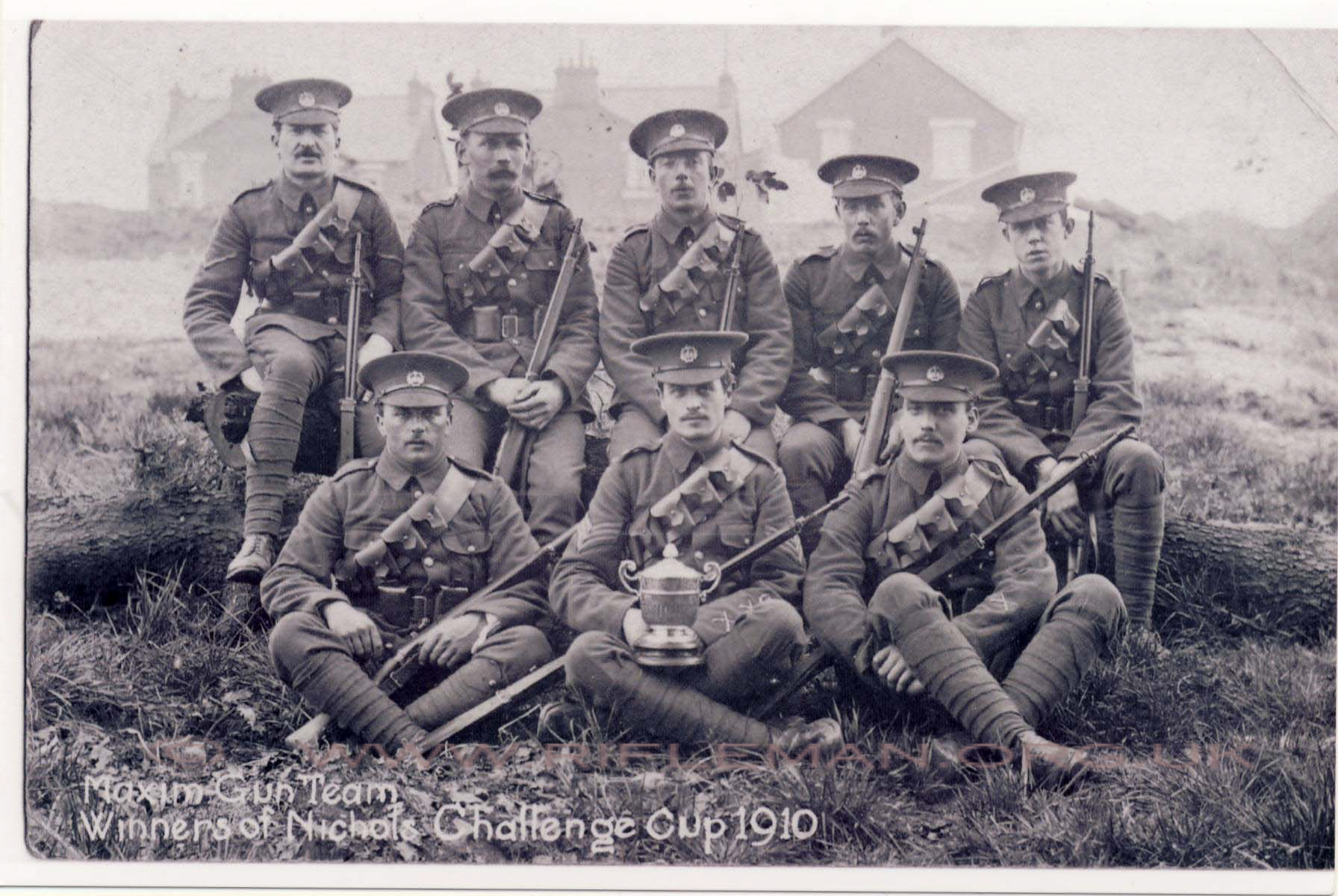
John Tippins posing with a number of his trophies and medals.
The rifle is a ......................?
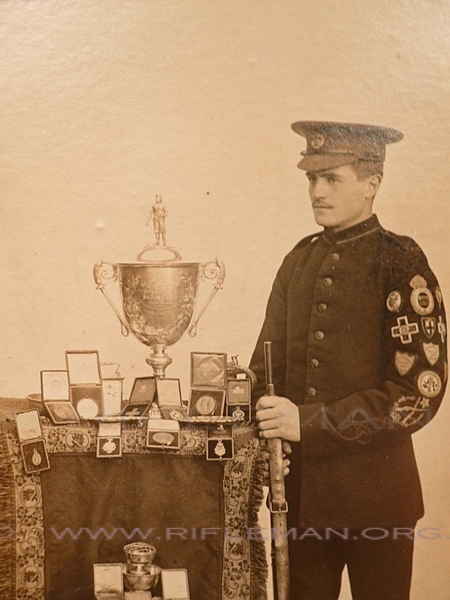
John was a keen motorcyclist.

Sergeant John Tippins (right) with his Rudge Multi Motorcycle

A contemporary report of John Tippins' prowess
told of some of the feats he occasionally performed at special events.
'Since then his records are too numerous to mention. He won the Championship,
last year, of the North London Rifle Club, and also won the Astor Championship
Competition at the Miniature N.R.A. Bisley at the Agricultural Hall (possibly
in Vincent Sq., nr. Vauxhall, South London - eventually held at Alexandra
Palace - Ed). For miniature shooting his favourite rifles are the Winchester
Musket and the B.S.A. Martini with heavy barrel, and his pet occupation
is shooting for groups, without much caring whether the group be in the bull
or not.
At rapid, disappearing, and moving targets he is a marvel, and I must recount
how at the Beckton Meeting last year, he really conjured a shot on to his
target. The competition was ten shots rapid at fifty yards. He had a misfire,
and in ejecting left the bullet in the chamber. Quick as lightning with
his right hand he grabbed a live cartridge, and between his finger and thumb
broke out the bullet, and holding his rifle muzzle up inserted the cartridge
with priming and powder only and fired out the bullet left in the chamber,
and scored a carton. I never saw anything prettier, and marvelled at his
coolness. If ever we get in a tight corner, and have to take up arms, may
we have many men like "Mr. John" to get us out of our difficulties.'
Below: John Tippins, believed to be holding the rifle bullet described in the article above.


Above: John Tippins's Essex Regiment TF army jacket covered with the many shooting badges
won by him between 1905 and 1913 whilst representing England.
Photograph by the late John Hopes, by courtesy of the trustees of the ESSEX REGIMENT MUSEUM, Chelmsford
Another sleeve, cut from one of Tippin's shooting jackets.
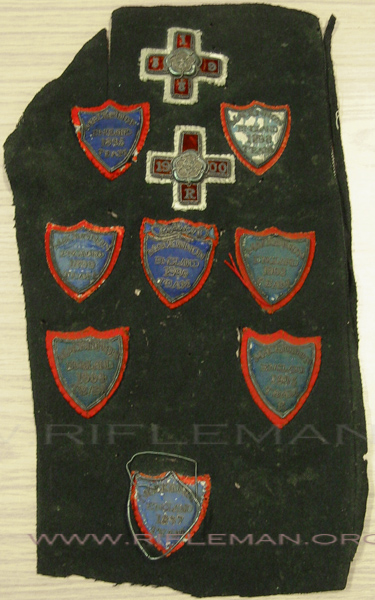
John Tippins' death was even reported by an Antipodean periodical.
Page six of the Melbourne (Victoria) 'Argus', carried the following piece.
"Another member of the British rifle team that
was to have visited Australia at the latter end of
last year has been killed in action, viz., Sergeant
J. Tippins (5th Essex), who received his death
wound whilst engaged in bringing water for the
Maxim gun he was working. His performances at
Bisley stamped him as a marksman of more than
ordinary ability, he having for the last six years in
succession been included in the King's final 100.
Corporal Tippins was well known amongst Austra-
lian riflemen who have visited Bisley, who speak
of him as a marksman of the highest order. He
was a son of L. R. Tippins, and 28 years of age."
Not well known is John Tippins expertise as a campanologist.
His death on the Somme was well reported in bell-ringing circles.
_copy.jpg)

John's name is recorded, fifth from last, on the roll of honour at an unidentified site.
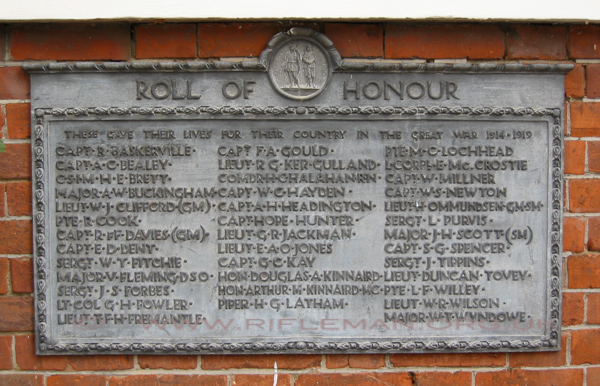
His gravestone, at the IWG Essex Cemetary.

His family descendents still hold his spotting telescope,
engraved with his name and regiment; 2nd. Essex.
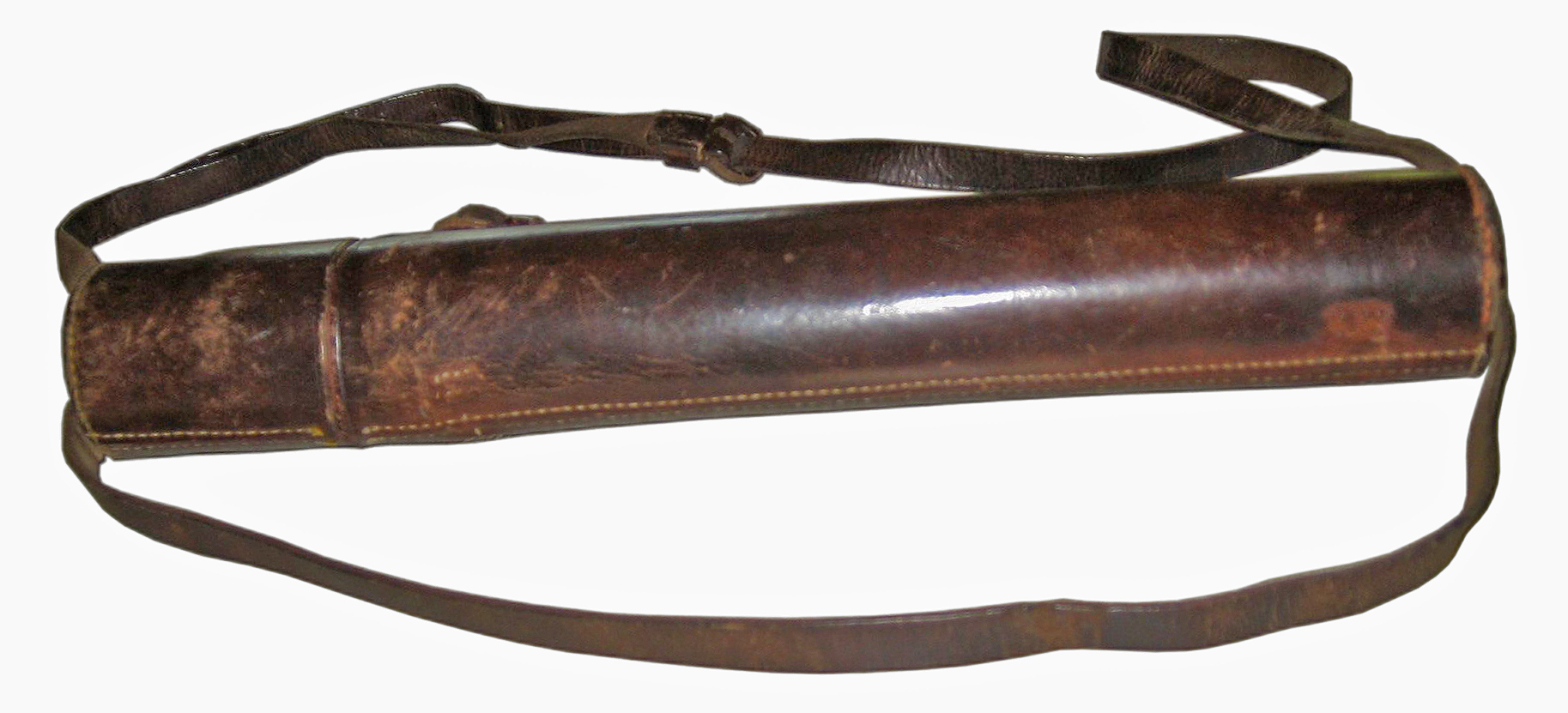


John's C.O., Captain Binstead, wrote well of him in a short obituary,
mentioning Sergeant Tippins prowess as a sharpshooter.
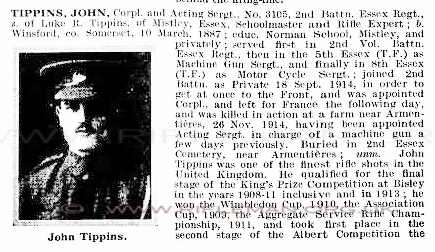

The Tippins father and son were still being markedly remembered by the shooting community as late as 1961, when the December edition of The Shooting Times & Country Magazine carried an article by none other than the famous Major E.G.B. Reynolds, author of the particularly well-known and authoratative reference volume " The Lee-Enfield Rifle"; (first published in 1960).
We are fortunately able, by the kind attention of a contributor,
to illustrate a searchable facsimile of the article.
As a finalé, we have put together a scrapbook of photographs and newspaper cuttings, again as a flip-page document.
Double tap tablet or click ロ for full page display.
* Harpenden Historical Society
See also Tippins' articles on our page of Historical
notes and extracts
and the COLCHESTER RIFLE CLUB HISTORY 1900
in which you can read more of both Luke
Return to: TOP of PAGE
See this website's Raison d'être